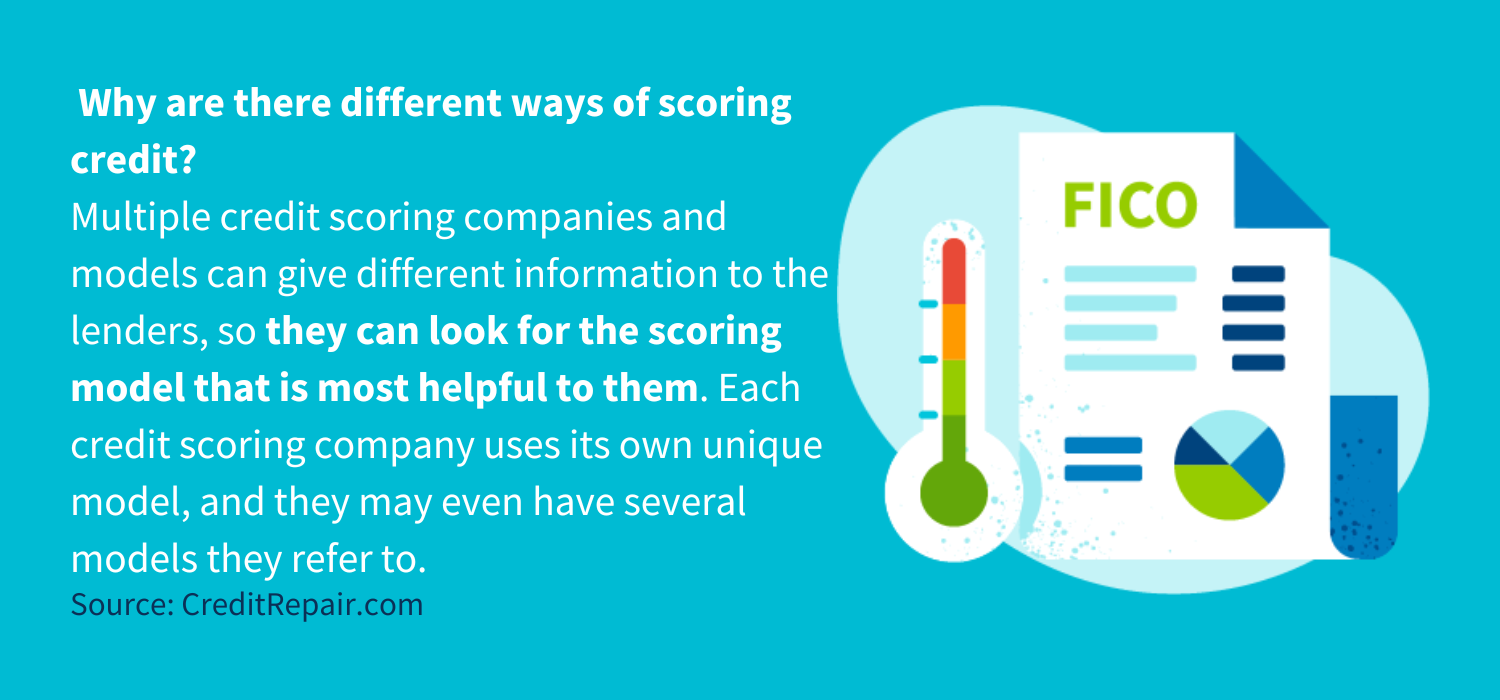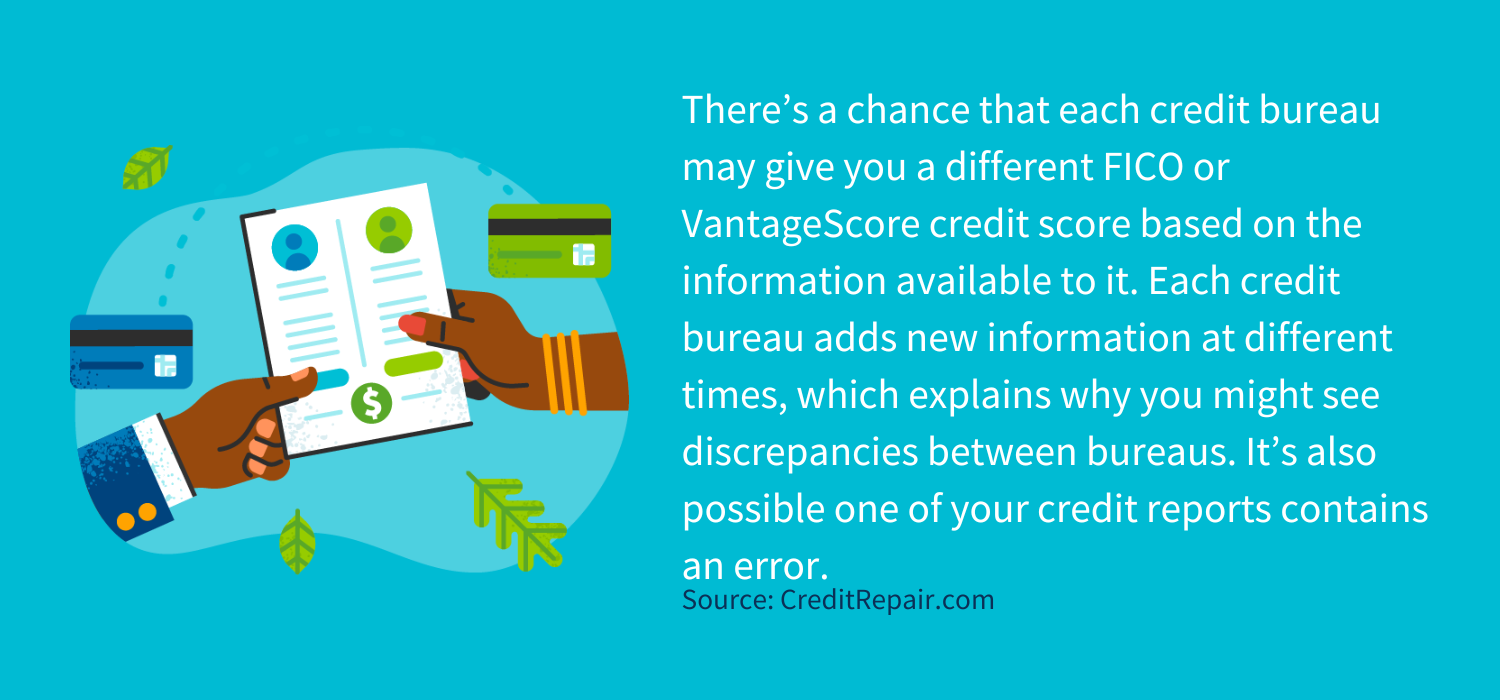
Disclosure regarding our editorial content standards.
Any time you apply for a new line of credit or a loan, the financial institution will want a copy of your credit report. Your credit report includes a lot of important personal information, including credit account history and past inquiries. The process of calculating a credit score is complex, and several factors are involved.
Just as there are different types of credit lines, such as credit cards and mortgages, there are different types of credit scores calculated based on the information a credit scoring company can access.
What are credit scores?
A credit score is a three-digit number typically calculated on a scale from 300 to 850. Your credit score is determined by the information contained in your credit report, which is compiled by a credit reporting bureau. The three main credit reporting bureaus are Experian®, Equifax® and TransUnion®.
A lower credit score may indicate you’re more likely to be a credit risk, based on the information on your credit report. If you have a higher score, you’re sending lenders the message that you’re a responsible borrower.
Although there are many types of credit scores available, the FICO® and VantageScore models are the two most commonly used credit scoring scales. Every score falls within a specific credit score range, which gives lenders an idea of what your credit risk is and what doing business with you will be like.
Why are there different ways of scoring credit?

Having different credit scores is normal if you’re getting information from credible sources. Multiple credit scoring companies and models can give different information to the lenders, so they can look for the scoring model that is most helpful to them. Each credit scoring company uses its own unique model, and they may even have several models they refer to.
Each model uses information from one or a combination of credit reports to calculate its results. Your score is generated based on what information they have access to and how they assign different levels of importance to that information. The type of credit you’re applying for and what day your score was calculated can also impact your credit score.
Because there are multiple credit scoring companies and models to use, it makes sense that your credit score will differ depending on the different resources and methods.
The FICO model
Originally known as Fair Isaac Corporation, FICO created the first standardized credit scoring model back in 1989. The company has created multiple versions of its model, and each targets a different lending requirement to match the range of financial services offered in the U.S.
All FICO scores generally range from 300 to 850, with anything between 670 and 739 qualifying as a good credit score. Your score is calculated based on five categories, with each category making up a percentage of your score:
- Payment history – 35 percent
- Credit utilization – 30 percent
- Length of credit history – 15 percent
- New credit – 10 percent
- Types of credit being used – 10 percent
All versions of the FICO model use this weighted system to calculate credit scores. The only difference is how each credit model calculates each of the categories.
The type of credit you’re applying for will determine which version of the FICO score is being used. These models are industry-specific, with options such as the FICO Bankcard score and the FICO Auto score. For example, if you apply for an auto loan, your FICO score is calculated to predict how likely you are to keep up with the monthly payments.
MyFico.com sells two versions of FICO scores to consumers, which are the FICO 8 score and the FICO mortgage score. This is the only place a consumer can buy a score. Other scoring models are sold to financial institutions.
The VantageScore model
VantageScores are sold by VantageScore Solutions, LLC, a subsidiary of TransUnion LLC. The VantageScore was established in 2006 to compete with FICO, and the company claims its scoring models were the first to compile data from all three of the major credit bureaus. This method allows your score to be calculated with greater accuracy.
VantageScore offers a few models, such as VantageScore 3.0 and VantageScore 4.0. Each model uses a rating scale of 300 to 850 but has a different method to calculate credit scores. A score that falls between 661 and 780 is usually considered a good credit score.
There are a few weighted factors that VantageScore considers in its scoring models:
- Credit utilization, balance and availability: extremely influential
- Types of accounts or credit mix: highly influential
- Payment history: moderately influential
- Credit history: less influential
- New credit: less influential
With VantageScore’s weighted factors, you can see exactly how each one impacts your score, giving you an idea of how to improve your credit score.
Other credit scoring models
Although FICO and VantageScore are the two most commonly used models, they’re not the only ones available. Many lenders use their own version of a credit scoring model to make decisions.
Some credit bureaus, such as Equifax, also use their own model to provide credit scores. Instead of the traditional rating scale of 300 to 850, Equifax rates credit scores from 280 to 850.
There are also cases when a credit score provider may try to pass its scores off as unique, but it actually uses the FICO or VantageScore models. TransUnion, for example, doesn’t use its own model to calculate credit scores but VantageScore 3.0.
Why are your scores from the credit bureaus different?

There’s a chance that each credit bureau may give you a different FICO or VantageScore credit score based on the information available to it.
For instance, your credit score is impacted when you make a large purchase that takes up a significant percentage of your available credit. You’ll see a drop in your credit score until you lower your balance, but one credit bureau may report that drop quicker than others.
Each credit bureau adds new information at different times, which explains why you might see discrepancies between bureaus. It’s also possible one of your credit reports contains an error.
By reviewing your credit reports on a regular basis with each bureau, you can stay informed about the information on your report and dispute anything that doesn’t look right to you.
How do you check your credit score?
There are a few ways to check your credit score. Many credit card issuers and banks provide account holders with free credit scores.
Apps such as Discover Credit Scorecard and CreditWise from Capital One let you check your credit score even if you don’t have a credit card with them. The budget tracking app, Mint, also offers users unlimited access to its VantageScore credit score.
A credit monitoring service is another option you can sign up for. These services update credit score information and track your credit report for potential identity or security risks. You may be able to find free options, but most credit monitoring services charge a fee, such as an annual or monthly subscription.
As you can see, there are many types of credit scores that are calculated using different methods. There’s also a range of services available that can help you gain a comprehensive understanding of how your score is calculated and which factors are impacting it the most.
If you’re concerned about any inaccuracies on your credit report that may be affecting your credit score, CreditRepair.com offers resources to educate you on your credit and help you take control of your financial future.
Note: The information provided on CreditRepair.com does not, and is not intended to, act as legal, financial or credit advice; instead, it is for general informational purposes only.
Questions about credit repair?
Chat with an expert: 1-800-255-0263






